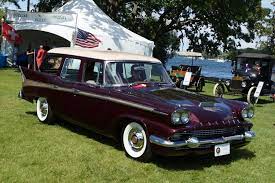On August 19, 1958, an era in American automotive history came to an end with the production of Packard cars ceasing. The closure of Packard, once a prominent and prestigious automobile manufacturer, marked a significant milestone in the decline of the independent American car companies and signaled a shift in the automotive industry landscape. Packard Motor Car Company had a long and storied history that dated back to its founding in 1899. Known for its luxury vehicles, Packard gained a reputation for quality, craftsmanship, and innovation. The company experienced success throughout the early 20th century, with its cars being favored by affluent customers and even serving as official vehicles for U.S. presidents. However, by the 1950s, Packard began to face numerous challenges that would ultimately lead to its demise. The rise of larger, more powerful, and technologically advanced automobiles from competitors like General Motors, Ford, and Chrysler put pressure on Packard to keep up with changing consumer demands. Additionally, the economic downturn following World War II and the increasing popularity of smaller, more fuel-efficient cars further impacted Packard's sales and financial stability. In an attempt to stay afloat, Packard entered into a merger with Studebaker in 1954. The merger was intended to create a stronger competitor in the automobile market, but it ultimately proved unsuccessful. The two companies struggled to integrate their operations and faced financial difficulties, leading to a decline in quality and a loss of customer confidence. By 1958, Packard's financial situation had deteriorated to the point where the company could no longer sustain car production. On August 19, 1958, the last Packard, a four-door sedan, rolled off the assembly line at the Packard plant in Detroit, Michigan. The closure of Packard marked the end of an era for American luxury car manufacturing, leaving behind a legacy of elegance and craftsmanship. The demise of Packard reflected broader trends in the American automobile industry during the mid-20th century. Independent automakers, once thriving and innovative, struggled to compete with the larger, more established companies that had greater resources and economies of scale. Many independent car companies either merged with larger manufacturers or ceased production altogether. The closure of Packard also symbolized the increasing dominance of the Big Three automakers - General Motors, Ford, and Chrysler - in the American market. These companies had the financial resources, production capabilities, and marketing prowess to adapt to changing consumer preferences and technological advancements. As a result, independent car manufacturers like Packard found it increasingly challenging to compete. Despite its closure, Packard's legacy endures. The brand is still recognized for its classic designs, quality craftsmanship, and its contribution to automotive history. Collectors and enthusiasts continue to appreciate and preserve Packard cars, ensuring that the memory of the once-great American luxury automaker lives on.
19 Aug, 1958 Packard Cars End Production
